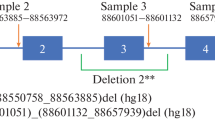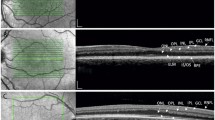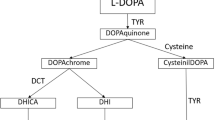Abstract
Oculocutaneous albinism (OCA) is a common human genetic condition resulting from mutations in at least twelve different genes. OCA1 results from mutations of the tyrosinase gene and presents with the life-long absence of melanin pigment after birth (OCA1A) or with the development of minimal-to-moderate amounts of cutaneous and ocular pigment (OCA1B). Other types of OCA have variable amounts of cutaneous and ocular pigment. We hypothesized that white hair at birth indicates OCA1 and tested this in a sample of 120 probands with OCA and white hair at birth. We found that 102 (85%) of the probands had OCA1 with one or two identifiable tyrosinase gene mutations, with 169 (83%) of the 204 OCA1 tyrosinase gene alleles having identifiable mutations and 35 (17%) having no identifiable change in the coding, splice junction, or proximal promoter regions of the gene. The inability to identify the mutation was more common with OCA1B (24/35, 69%) than with OCA1A (11/35, 31%) alleles. Seven probands with no tyrosinase gene mutations were found to have OCA2 with one or two P gene mutations, and in eleven, no mutations were detected in either gene. We conclude that (1) the presence of white hair at birth is a useful clinical tool suggesting OCA1 in a child or adult with OCA, although OCA2 may also have this presentation; (2) the molecular analysis of the tyrosinase and P genes are necessary for precise diagnosis; and (3) the presence of alleles without identifiable mutations of the tyrosinase gene, particularly in OCA1B, suggests that more complex mutation mechanisms of this gene are common in OCA.



Similar content being viewed by others
References
Anikster Y, Huizing M, White J, Shevchenko YO, Fitzpatrick DL, Touchman JW, Compton JG, Bale SJ, Swank RT, Gahl WA, Toro JR (2001) Mutation of a new gene causes a unique form of Hermansky-Pudlak syndrome in a genetic isolate of central Puerto Rico. Nat Genet 28:376–380
Gahl WA, Brantly M, Kaiser-Kupfer MI, Iwata F, Hazelwood S, Shotelersuk V, Duffy LF, Kuehl EM, Troendle J, Bernardini I (1998) Genetic defects and clinical characteristics of patients with a form of oculocutaneous albinism (Hermansky-Pudlak syndrome). N Engl J Med 338:1258–1264
Gardner JM, Nakatsu Y, Gondo Y, Lee S, Lyon MF, King RA, Brilliant MH (1992) The mouse pink-eyed dilution gene: association with human Prader-Willi and Angelman syndromes. Science 257:1121–1124
Gershoni-Baruch R, Rosenmann A, Droetto S, Holmes S, Tripathi RK, Spritz RA (1994) Mutations of the tyrosinase gene in patients with oculocutaneous albinism from various ethnic groups in Israel. Am J Hum Genet 54:586–594
Giebel LB, Tripathi RK, King RA, Spritz RA (1991a) A tyrosinase gene missense mutation in temperature-sensitive type I oculocutaneous albinism. J Clin Invest 87:1119–1122
Giebel LB, Tripathi RK, Strunk KM, Hanifin JM, Jackson CE, King RA, Spritz RA (1991b) Tyrosinase gene mutations associated with type IB ("yellow") oculocutaneous albinism. Am J Hum Genet 48:1159–1167
Halaban R, Svedine S, Cheng E, Smicun Y, Aron R, Hebert DN (2000) Endoplasmic reticulum retention is a common defect associated with tyrosinase-negative albinism. Proc Natl Acad Sci USA 97:5889–5894
Hazelwood S, Shotelersuk V, Wildenberg SC, Chen D, Iwata F, Kaiser-Kupfer MI, White JG, King RA, Gahl WA (1997) Evidence for locus heterogeneity in Puerto Ricans with Hermansky-Pudlak syndrome. Am J Hum Genet 61:1088–1094
Huizing M, Anikster Y, Fitzpatrick DL, Jeong AB, D'Souza M, Rausche M, Toro JR, Kaiser-Kupfer MI, White JG, Gahl WA (2001a) Hermansky-pudlak syndrome type 3 in Ashkenazi Jews and other non-Puerto Rican patients with hypopigmentation and platelet storage-pool deficiency. Am J Hum Genet 69:1022–1032
Huizing M, Anikster Y, Gahl WA (2001b) Hermansky-Pudlak syndrome and Chediak-Higashi syndrome: disorders of vesicle formation and trafficking. Thromb Haemost 86:233–245
Introne W, Boissy RE, Gahl WA (1999) Clinical, molecular, and cell biological aspects of Chediak-Higashi syndrome. Mol Genet Metab 68:283–303
King RA, Townsend D, Oetting WS, Summers CG, Olds DP, White JG, Spritz RA (1991) Temperature-sensitive tyrosinase associated with peripheral pigmentation in oculocutaneous albinism. J Clin Invest 87:1046–1053
King RA, Hearing VJ, Creel DJ, Oetting WS (2001a) Albinism. In: Scriver CR, Beaudet AL, Sly WS, Valle D (eds) The metabolic and molecular bases of inherited disease, 8th edn. McGraw-Hill, New York, pp 5587–5627
King RA, Oetting WS, Summers CG, Creel DJ, Hearing V (2001b) Abnormalities of pigmentation. In: Rimoin DL, Connor JM, Pyeritz RE, Korf BR (eds) Emery and Rimoin's principles and practice of medical genetics, 4th edn. Harcourt, London
Lee S-T, Nicholls RD, Bundey S, Laxova R, Musarella M, Spritz RA (1994a) Mutations of the P gene in oculocutaneous albinism, ocular albinism, and Prader-Willi syndrome plus albinism. N Engl J Med 330:529–534
Lee S-T, Nicholls RD, Schnur RE, Guida LC, Lu-Kuo J, Spinner NB, Zackai EH, Spritz RA (1994b) Diverse mutations of the P gene among African-Americans with type II (tyrosinase-positive) oculocutaneous albinism (OCA2). Hum Mol Genet 3:2047–2051
Li W, Zhang Q, Oiso N, Novak EK, Gautam R, O'Brien EP, Tinsley CL, Blake DJ, Spritz RA, Copeland NG, Jenkins NA, Amato D, Roe BA, Starcevic M, Dell'Angelica EC, Elliott RW, Mishra V, Kingsmore SF, Paylor RE, Swank RT (2003) Hermansky-Pudlak syndrome type 7 (HPS-7) results from mutant dysbindin, a member of the biogenesis of lysosome-related organelles complex 1 (BLOC-1). Nat Genet 35:84–89
Li Q, Harju S, Peterson KR (1999) Locus control regions: coming of age at a decade plus. Trends Genet 15:403–408
Matsunaga J, Dakeishi-Hara M, Tanita M, Nindl M, Nagata Y, Nakamura E, Miyamura Y, Kikuchi K, Furue M, Tomita Y (1999) A splicing mutation of the tyrosinase gene causes yellow oculocutaneous albinism in a Japanese patient with a pigmented phenotype. Dermatology 199:124–129
Montoliu L, Umland T, Schütz G (1996) A locus control region at −12 kb of the tyrosinase gene. EMBO J 15:6026–6034
Newton JM, Cohen-Barak O, Hagiwara N, Gardner JM, Davisson MT, King RA, Brilliant MH (2001) Mutations in the human orthologue of the mouse underwhite gene (uw) underlie a new form of oculocutaneous albinism, OCA4. Am J Hum Genet 69:981–988
Oetting WS, King RA (1999) Molecular basis of albinism: mutations and polymorphisms of pigment genes associated with albinism. Hum Mutat 13:99–115
Oetting WS, Handoko HY, Mentink MM, Paller AS, White JG, King RA (1991a) Molecular analysis of an extended family with type IA (tyrosinase-negative) oculocutaneous albinism. J Invest Dermatol 97:15–19
Oetting WS, Mentink MM, Summers CG, Lewis RA, White JG, King RA (1991b) Three different frameshift mutations of the tyrosinase gene in type IA oculocutaneous albinism. Am J Hum Genet 49:199–206
Oetting WS, Witkop CJ, Brown S, Colomer R, Fryer JP, Bloom KE, King RA (1992) A frequent mutation in the tyrosinase gene associated with type I-A (tyrosinase-negative) oculocutaneous albinism in Puerto Rico. Am J Hum Genet 50:1-10
Passmore LA, Kaesmann-Kellner B, Weber BH (1999) Novel and recurrent mutations in the tyrosinase gene and the P gene in the German albino population. Hum Genet 105:200–210
Pearson K, Nettleship E, Usher CH (1911) A monograph on albinism in man: Drapers' Company Research Memoirs, Biometric Series VI. Dulau, London
Porter S, Larue L, Mintz B (1991) Mosaicism of tyrosinase-locus transcription and chromatin structure in dark vs light melanocyte clones of homozygous chincilla-mottled mice. Dev Genet 12:393–402
Puri N, Durham-Pierre D, Aquaron R, Lund PM, King RA, Brilliant MH (1997) Type 2 oculocutaneous albinism (OCA2) in Zimbabwe and Cameroon: distribution of the 2.7-kb deletion allele of the P gene. Hum Genet 100:651–656
Rinchik EM, Bultman SJ, Horsthemke B, Lee S, Stunk KM, Spritz RA, Avidano KM, Jong MTC, Nicholls RD (1993) A gene for the mouse pink-eyed dilution locus and for human type II oculocutaneous albinism. Nature 361:72–76
Saiki RK, Gelfand DH, Stoffel S, Scharf SJ, Higuchi R, Horn GT, Mullis KB, Erlich HA (1988) Primer-directed enzymatic amplification of DNA with a thermostable DNA polymerase. Science 239:487–491
Schnur RE, Selling BT, Holmes SA, Wick PA, Tatsumura YO, Spritz RA (1996) Type I oculocutaneous albinism associated with a full-length deletion of the tyrosinase gene. J Invest Dermatol 106:1137–1140
Shotelersuk V, Gahl WA (1998) Hermansky-Pudlak syndrome: models for intracellular vesicle formation. Mol Genet Metab 65:85–96
Shotelersuk V, Hazelwood S, Larson D, Iwata F, Kaiser-Kupfer MI, Kuehl E, Bernardini I, Gahl WA (1998) Three new mutations in a gene causing Hermansky-Pudlak syndrome: clinical correlations. Mol Genet Metab 64:99–107
Shotelersuk V, Dell'Angelica EC, Hartnell L, Bonifacino JS, Gahl WA (2000) A new variant of Hermansky-Pudlak syndrome due to mutations in a gene responsible for vesicle formation. Am J Med 108:423–427
Silvers WK (1979) The coat colors of mice. A model for mammalian gene action and interaction. Springer, Berlin Heidelberg New York
Spritz RA (1993) Molecular genetics of oculocutaneous albinism. Semin Dermatol 12:167–172
Spritz RA, Strunk KM, Giebel LB, King RA (1990) Detection of mutations in the tyrosinase gene in a patient with Type IA oculocutaneous albinism. N Engl J Med 322:1724–1728
Spritz RA, Oh J, Fukai K, Holmes SA, Ho L, Chitayat D, France TD, Musarella MA, Orlow SJ, Schnur RE, Weleber RG, Levin AV (1997) Novel mutations of the tyrosinase (TYR) gene in type 1 oculocutaneous albinism (OCA1). Hum Mutat 10:171–174
Tomita Y, Takeda A, Okinaga S, Tagami H, Shibahara S (1989) Human oculocutaneous albinism caused by a single base insertion in the tyrosinase gene. Biochem Biophys Res Commun 164:990–996
Toyofuku K, Wada I, Spritz RA, Hearing VJ (2001) The molecular basis of oculocutaneous albinism type 1 (OCA1): sorting failure and degradation of mutant tyrosinases results in a lack of pigmentation. Biochem J 355:259–269
Tripathi RK, Hearing VJ, Urabe K, Aroca P, Spritz RA (1992) Mutational mapping of the catalytic activities of human tyrosinase. J Biol Chem 267:23707–23712
Tripathi RK, Bundey S, Musarella MA, Droetto S, Strunk KM, Holmes SA, Spritz RA (1993) Mutations of the tyrosinase gene in Indo-Pakistani patients with Type I (tyrosinase-deficient) oculocutaneous albinism (OCA). Am J Hum Genet 53:1173–1179
White JG, Witkop CJ, Gerritsen SM (1973) The Hermansky-Pudlak syndrome: ultrastructure of bone marrow macrophages. Am J Pathol 70:329–344
Witkop CJ, Krumwiede M, Sedano H, White JG (1987) The reliability of absent platelet dense bodies as a diagnostic criterion for Hermansky-Pudlak syndrome. Am J Hematol 26:305–300
Zhang Q, Zhao B, Li W, Oiso N, Novak RK, Rusiniak ME, Gautam R, Chintala S, O'Brien EP, Zhang Y, Roe BA, Elliott RW, Eicher EM, Liang P, Kratz C, Legius E, Spritz RA, O'Sullivan TN, Copeland NG, Jenkins NASRT (2003) Ru2 and Ru encode mouse orthologs of the genes mutated in human Hermansky-Pudlak syndrome types 5 and 6. Nat Genet 33:145–153
Acknowledgements
The authors thank the wonderful families who have participated in this research and the many physicians who have referred the families to the International Albinism Center. This research was supported in part by United States Public Health grant AR44649 and by the Bernard and Mary Ellen Black family.
Author information
Authors and Affiliations
Corresponding author
Additional information
Electronic database Information: accession numbers and URLs for data presented in this article are as follows:
Albinism Database, http://www.cbc.umn.edu/tad, for a list of published mutations of the tyrosinase gene
Online Mendelian Inheritance in Man (OMIM), http://www.ncbi.nlm.nih.gov/Omim/, for OCA1 (MIM 203100), OCA2 (MIM 203200)
Rights and permissions
About this article
Cite this article
King, R.A., Pietsch, J., Fryer, J.P. et al. Tyrosinase gene mutations in oculocutaneous albinism 1 (OCA1): definition of the phenotype. Hum Genet 113, 502–513 (2003). https://doi.org/10.1007/s00439-003-0998-1
Received:
Accepted:
Published:
Issue Date:
DOI: https://doi.org/10.1007/s00439-003-0998-1




